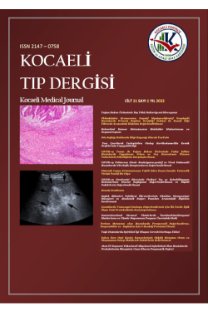Demir eksikliği anemisi nedeniyle takipli hastalarda endoskopi sonuçları
Endoscopic examination results in patients with iron deficiency anemia
___
- 1- Beutler E, Waalen J. The definition of anemia: what is the lower limit of normal of the blood hemoglobin concentration? Blood 2006; 107: 1747- 50.
- 2- Nalbant S, Karan MA. İç Hastalıkları Uzmanının Anemiye Yaklaşımı Rehberi. İç Hastalıkları Dergisi 2010; 17:7-15.
- 3- Provan D. Mechanism and management of iron deficiency anemia. Br J Haematol 1999; 105:19-26.
- 4- Hardwick RH, Armstrong CP. Synchronous upper and lower gastrointestinal endoscopy is an effective method of investigating iron-deficiency anemia. Br J Surg 1997; 84:1725-8.
- 5- Çetinkaya ZA, Sezikli M, Güzelbulut F, ve ark. Demir eksikliği anemili hastalarda gastrointestinal endoskopik inceleme sonuçları. Dicle Tıp Dergisi 2011; 38:155-59.
- 6- Kepczyk T, Kadakia SC. Prospective evaluation of gastroin testinal tract in patients with irondeficiency anemia. Dig Dis Sci 1995; 40:1283-9.
- 7- Appropriate use of gastrointestinal endoscopy. A consensus statement from the American Society for Gastrointestinal Endoscopy. Gastrointest Endosc 2000; 52:831-7.
- 8- Ünal ÜH, Fidan C, Korkmaz M, Selçuk H. Demir eksikliği olan hastalarda gastrointestinal sistem endoskopi bulguları. Akademik Gastroenteroloji Dergisi 2012; 3:113-16.
- 9- James MW, Chen CM, Goddard WP, et al. Risk factors for gastrointestinal malignancy in patients with iron-deficiency anaemia. Eur J Gastroenterol Hepatol 2005; 17:1197-203.
- 10- Ertekin V, Tozun MS, Küçük N. The prevalence of celiac disease in children with iron-deficiency anemia. Turk J Gastroenterol 2013; 24:334-8.
- 11- Emami MH, Karimi S, Kouhestani S. Is routine duodenal biopsy necessary for the detection of celiac disease in patients presenting with iron deficiency anemia? Int J Prev Med 2012; 3:273-7.
- 12- Okuturlar Y, Soylu A, İnan Y, et al. Lower and upper endoscopic examination results in patients with iron deficiency anemia. Endoscopy Gastrointestinal 2014; 22:33-7.
- ISSN: 2147-0758
- Yayın Aralığı: 3
- Başlangıç: 2012
- Yayıncı: -
Pediatrik ses bozuklukları ve ses terapisinin etkinliği
Elçin Tadıhan ÖZKAN, Erhan DEMİRHAN
kronik böbrek hastalarında ortalama trombosit hacmi ölçümü standardizasyona ihtiyaç gösterir
Griggs tekniği ile açılan perkütan trakeostomi deneyimlerimiz: 38 olgu
Sema ÖNCÜL, MEHMET YILMAZ, Elif Atar GAYGUSUZ, Duygu Akalın OYSU, Osman ESEN, Tahsin ŞİMŞEK, Mehmet Hamdi AYTEKİN, Hilal Doğan ALCAL, Başol BAY
Semptomatik diz osteoartritinde vitamin D düzeyi: klinik ve radyolojik parametrelerle ilişkisi
Tuba GÜLER, Yeşim GARİP, Pelin YILDIRIM, Rabia TERZİ
Özgür DİKME, Özlem DİKME, Hakan TOPAÇOĞLU
Demir eksikliği anemisi nedeniyle takipli hastalarda endoskopi sonuçları
SELÇUK YAYLACI, Ahmet Bilal GENÇ, Ali TAMER, Hakan CİNEMRE, Mustafa İhsan USLAN
Dyke-Davidoff-Masson sendromu: olgu sunumu
Mehtap ÇAVUŞOĞLU, Semra DURAN, Eda ELVERİCİ, Enis YÜKSEL
Subaraknoid kanama sonrası erken beyin hasarı
Murat ULUTAŞ, Haydar SEKMEN, Mehmet SEÇER, Soner ŞAHİN
Hakan PARLAR, Özgür BARIŞ, Ersan OZBUDAK, Şadan YAVUZ, Muhip KANKO, Kamil Turan BERKİ
